
Fast, affordable Internet access for all.

When a $25 million broadband funding award for the Colorado River Indian Tribe (CRIT) was announced in July 2023, CRIT Chairwoman Amelia Flores celebrated it as a “game changer.”
“Broadband access is essential,” Flores’s statement read, making “remote learning, telecommuting, conducting business, and simplifying staying connected” possible.
Coming amid a rolling series of announcements from the Tribal Broadband Connectivity Program – each lauding millions of dollars in broadband funding for Tribes – it would have been easy to file away CRIT’s award as another from that pathbreaking broadband funding program for Tribes.
But this was not the TBCP. Rather, CRIT was among a handful of Tribes that received substantial funding awards from another federal source that has recently stepped up their grantmaking to Tribes – the U.S. Department of Agriculture’s (USDA) ReConnect Grant Program, administered by the department’s Rural Utilities Service (RUS).
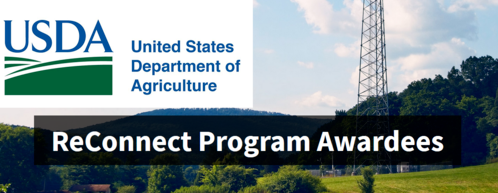
CRIT’s award is a helpful reminder that TBCP is not the be-all-end-all of funding for Tribal broadband. With an award cycle now open, ReConnect offers powerful tools and incentives – including dedicated Tribal funding, 100 percent grants, and consent for any new infrastructure on sovereign lands – for Tribes looking to expand or launch broadband service.
TBCP, ReConnect, and Federal Funding for Tribal Broadband Infrastructure
TBB11 marked an exciting development for the Tribal Broadband Bootcamps.
For this latest and newest iteration, TBB co-founder Matt Rantanen graciously permitted TBB to make a permanent fiber ring installation on his property, RantanenTown Ranch, last month. While TBB will continue to host bootcamps in partnership with Tribes in different regions of North America, the launch of this permanent broadband practice arena allows TBB to chart a new path towards even more in-depth and hands-on training.
Here is a photo-filled look at the many days of prep and three days of immersive programming that went into making it happen.
“Just the fact that we saw the fiber model in its open aspect with all the drama and issues right in front of us; my friends is the best learning methodology!” – TBB 11 Attendee
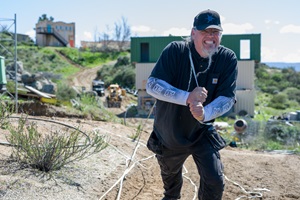
Ready or Not
Of course, building an entire, operating fiber network across RantanenTown Ranch was a massive undertaking that involved a lot of prep work.
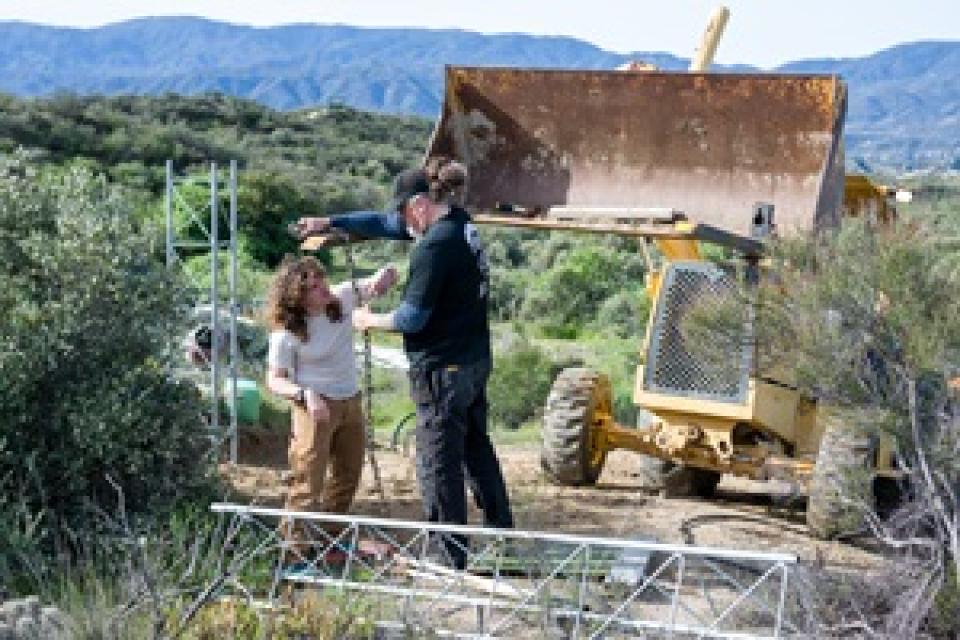
Officials in Washoe County, Nevada have struck a new public private partnership (PPP) with Digital Technology Solutions (DTS) to deploy affordable fiber service into the long-neglected rural towns of Gerlach and Empire, Nevada. The deal is part of a broader effort to bring affordable access to underserved residents just out of reach of broadband access.
Behzad Zamanian, Washoe County Chief Information Officer, tells ILSR that the county’s two-phased project first involved contracting with DTS to construct and maintain a $2.3 million middle-mile fiber network that connected Gerlach to Reno, culminating in a ribbon-cutting ceremony at the Gerlach Community Library last July.
“The reason [Gerlach] was identified as a high priority was that it was considered unserved or underserved; there was no presence of any of the major Internet service providers in that region,” he noted. “There was no high speed Internet available.”
Until last summer, area students and residents were completely cut off from online learning, employment services, remote health care, and other essential services and opportunities.
Expanding the middle mile network required close collaboration with the Pyramid Lake Paiute Tribe, which allowed the county to piggyback on the tribe’s existing fiber runs from Reno to Nixon, Nevada. The county then worked closely with the Nevada Office of Science, Innovation, and Technology (OSIT) and DTS to deploy fiber the remaining 60 miles from Nixon to Gerlach.
The Tribal Broadband Bootcamps (TBB) – a three-day intensive learning experience focused on building and running Tribal Internet networks – are becoming even more immersive as the 11th TBB is now underway at the homestead of TBB co-founder Matthew Rantanen.
As more Tribal nations build out their own broadband networks to deliver service to Indigenous communities in the most disconnected areas of North America, broadband-minded Tribal leaders and instructors continue to gather in different Tribal regions across the country several times a year for the ultimate Indian Country networking experience.
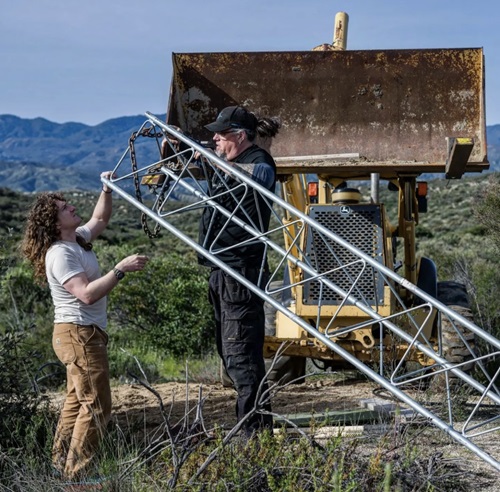
This time participants descended on “RantanenTown Ranch” in Aguanga, California – part of southern California’s Inland Empire region near Temecula.
With help from ILSR’s Community Broadband Networks Initiative Director and TBB co-founder Christopher Mitchell, and a handful of other instructors, the ranch has been transformed into a working demonstration site so participants could better learn the technologies involved in constructing broadband networks, while taking a deep-dive into what it takes to operate a network.
All of the previous bootcamps offered hands-on training. But, this particular bootcamp took it up a notch as TBB instructors set up a full deployment demonstration, illustrating how fiber is buried and/or deployed aerially.
Digging In
Los Alamos County, New Mexico joins the growing list of municipalities looking to explore a community-owned broadband network in a bid to improve resident access to fast, affordable, next-generation fiber.
The request for proposal (RFP), originally issued August 13, called for design, planning, and construction partners for a locally-owned and operated fiber network. An updated RFP was issued on December 12, 2023 stating that applications for phase two of their planned project were deemed “incomplete.” The county has given potential partners until January 12 to respond.
“The county team is now reviewing the submitted proposals,” the county states. “Once one is selected and an agreement finalized, the county will request the council award a contract. This may occur in early 2024.”
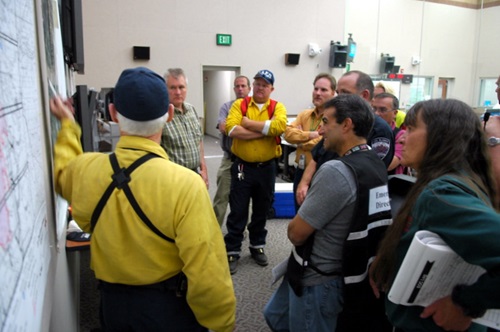
The RFPs come after county council leaders passed a motion last January declaring “…that high-quality reliable telecommunication including broadband is an essential service.” Los Alamos County officials did not respond to repeated requests for comment asking for more detail on the county’s goals. Local outlets suggest more details should emerge in 2024.
New Mexico is poised to receive more than $635 million in broadband subsidies courtesy of the Broadband Equity Access and Development (BEAD) program, made possible in turn by the 2021 Infrastructure Investment and Jobs Act.
We are pleased to announce an exciting lineup of Tribal Broadband Bootcamps (TBB) scheduled for 2024.
TBB was started in 2021 as an initiative to connect people interested in building Tribal broadband networks - a space for folks to develop and share best practices that ensure their communities have high-quality, equitable Internet access. More than fifty Tribes or First Nations and over three hundred participants have since attended a bootcamp, increasing their knowledge, sharing their expertise, and contributing to this vibrant community.
Sponsored by Waskawiwin in partnership with ILSR’s Community Broadband Networks Initiative, TBBs are three-day immersive learning and networking events. At TBB, hands-on and interactive activities enhance a curriculum of beginner and advanced material on wireless and fiber optic networks. Technical learning is paired with discussions on important topics like policy, funding, and digital equity.
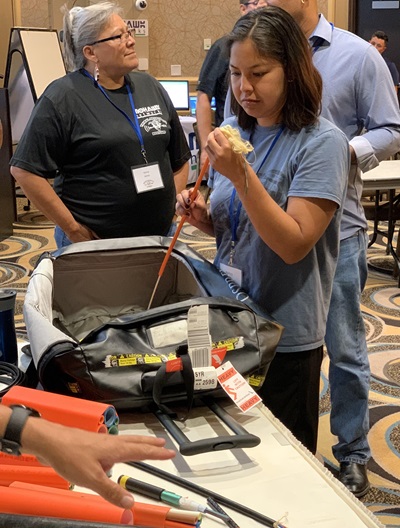
Participants with all levels of experience are encouraged to attend. Bringing together new learners and folks with decades of experience, the bootcamps create a unique opportunity for people across Indian Country to share strategies, challenges, and successes. Tribal Broadband Bootcamps help build community and capacity at the same time.
Whether you’re a technician, customer service specialist, general manager, or Tribal leader - if you’re interested in or focused on broadband in Indian Country, check out our upcoming bootcamps:
After decades of failed broadband policy-making and incumbent provider neglect, many Tribal communities continue to lack affordable and reliable Internet connectivity. Limited access to capital for last-mile deployment on Tribal lands has been exacerbated by a vast “missing middle mile” problem, and credible estimates put the costs of universal access on reservations at well over $10 billion.
Despite a historic investment in better Internet access from the federal government directly to Tribes, the problem is not even half solved. The first round of the Tribal Broadband Connectivity Program offered $2 billion in grants but received nearly $6 billion in requests from half of the 574 federally-recognized Tribes. With only $1 billion available in the final round of this program, an enormous funding gap remains.
Funding from the Broadband Equity, Access, and Deployment Program (BEAD) will have to be used strategically and collaboratively with Tribes to bridge this gap. The “high-cost area” match exemption could be an important tool to facilitate sustainable infrastructure deployment on Tribal lands, but it is not yet clear that states will make this exemption feasible.
The Tribal Business of Broadband webinar series, a virtual extension of the Tribal Broadband Bootcamps, continues later this month with a focus on wireless Tribal networks.
It will be held on December 19 at 2 pm ET.
As historic investments are being made to bring better broadband to Indian Country, the webinars are designed to be a practical resource for Tribal leaders seeking to expand high-speed Internet access within Indigenous communities.
Coming on the heels of the first webinar in the series, which focused on high-level business considerations in establishing Tribal networks, this second webinar will cover what it takes to deploy wireless networks, the spectrum licensing involved, and other related issues.
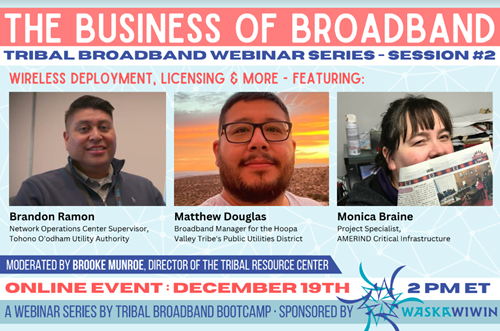
Like the previous webinar, the lineup of speakers bring in-depth knowledge and experience in the building and operation of Tribal networks. Speakers for the Dec. 19 webinar include: Brandon Ramon, Network Operations Center Supervisor for the Tohono O'odham Utility Authority; Matthew “Speygee” Douglas, Broadband Manager for the Hoopa Valley Tribe's Public Utilities District; and Monica Braine, Project Specialist for AMERIND Critical Infrastructure. The conversation will be moderated by Brooke Munroe, Director of the Tribal Resource Center.
Pre-registration is not required. Interested participants can watch the webinar live here.
The Tribal Broadband Connectivity Program (TBCP) is in the midst of accepting applications for a second round of funding, with nearly $1 billion in grants available. A significant program with important limitations, TBCP has made some changes in round two – including one that could mean the resurgence of old barriers for Tribes.
TBCP launched in 2021 with a total $3 billion in allocations, an unprecedented federal investment in Tribal broadband. The TBCP also requires no minimum match from Tribal governments, easing a long-time barrier to grant participation.
Interest in the program’s first round of funding was pronounced. After more than 300 applications requesting nearly $6 billion, NTIA selected 226 projects for award, to the tune of $1.9 billion. At least 70 of these were “equitable distribution” awards – a system that guaranteed any of the 574 federally recognized tribes with a satisfactory application up to $500,000. All together, these grants expect to reach more than 170,000 Tribal households.

This week on the podcast, Christopher speaks with Valerie Fast Horse, the IT director and creator of Red Spectrum for the Coeur d'Alene Tribe. Red Spectrum, a broadband company, serves the Coeur d'Alene Reservation in North Idaho, covering nearly 380,000 acres of land.
Chris and Valerie discuss the history of the Red Spectrum and the efforts made over time to upgrade its infrastructure and continue to offer residents high-quality connections – transitioning from fixed wireless to fiber-to-the-home projects.
Valerie also discusses how Red Spectrum has expanded its services over the years, including subscribers both inside the reservation and areas outside of it, as well as barriers to expanding and the challenges of competition from other providers such as Starlink.
Despite the challenges they face, Red Spectrum continues to grow its network and uphold its high customer satisfaction rate, even bringing back subscribers who originally left for Starlink. Chris and Valerie conclude the conversation by emphasizing the importance of personal interest, community involvement, and local talent in building small, successful community broadband networks.
This show is 22 minutes long and can be played on this page or via Apple Podcasts or the tool of your choice using this feed.
Transcript below.
We want your feedback and suggestions for the show-please e-mail us or leave a comment below.
Listen to other episodes or view all episodes in our index. See other podcasts from the Institute for Local Self-Reliance.
Thanks to Arne Huseby for the music. The song is Warm Duck Shuffle and is licensed under a Creative Commons Attribution (3.0) license.